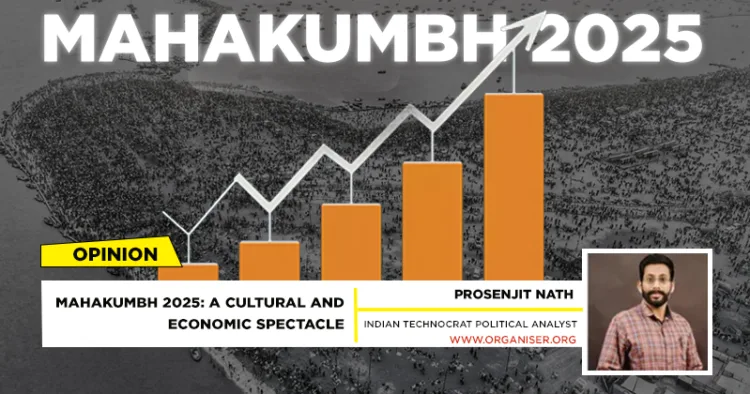The Mahakumbh Mela, one of the world’s largest religious gatherings, is a profound testament to India’s rich cultural heritage and dynamic interplay with modern governance and economics. The 2025 edition of this colossal event promises to transcend previous benchmarks, drawing an estimated 400 million pilgrims to Prayagraj over two months. This staggering convergence is not merely a spiritual phenomenon but also a monumental economic event with far-reaching implications. By examining its organisational magnitude, direct and indirect economic contributions, and policy implications, we uncover how the Mahakumbh embodies the symbiosis of culture, religion, and economics.
The Uttar Pradesh government’s preparations for the event are nothing short of extraordinary. A temporary district, Mahakumbh Nagar, has been established to manage the influx of pilgrims across a sprawling 40 square kilometer venue. Infrastructure investments include 1.5 lakh toilets, 10,000 changing rooms, and a transportation network comprising 7,500 buses and 3,000 special trains. Advanced technologies like artificial intelligence, drones, and enhanced energy systems have been deployed to streamline logistics and ensure an unparalleled consumer experience. These developments underscore how the Kumbh Mela serves as a microcosm of efficient urban planning and resource management, catalyzing economic activities across multiple sectors.
At the heart of this event lies the unprompted economic engagement of millions of devotees. Unlike traditional economic stimuli driven by government incentives or corporate interests, the Mahakumbh thrives on the intrinsic motivation of participants rooted in their dharmic way of life. Pilgrims’ discretionary spending on essentials like food, accommodation, travel, and religious paraphernalia demonstrates the economic agency embedded in cultural practices. This phenomenon not only amplifies consumer demand but also nurtures micro and small-scale enterprises specializing in religious goods and services. It is a reminder of how deeply ingrained cultural traditions can drive economic activity organically, independent of external economic policies or global market trends.
The economic impact of the Mahakumbh is monumental. In 2013, the event generated revenues of approximately Rs 1,200 crore, a figure that soared to Rs 1.2 lakh crore in 2019. Projections for 2025 estimate this revenue to touch Rs 2.5 lakh crore equivalent to nearly 10 per cent of Uttar Pradesh’s State Gross Domestic Product (SGDP). These figures reflect not only the direct economic contributions but also the massive ripple effects on ancillary industries such as tourism, hospitality, and transportation. The creation of 10 lakh job opportunities, both part-time and full-time, highlights the event’s role as a significant employment generator, catering to diverse skill sets and economic strata.
Beyond the immediate financial influx, the Mahakumbh leaves a legacy of infrastructure and services that benefit the local economy long after the event concludes. Consider the 1,249 km of pipelines installed to feed over 200 water ATMs and 85 water booths an investment that enhances urban utility services for years to come. Similarly, improved roads, transportation systems, and sanitation facilities not only elevate Prayagraj’s standing as a tourist destination but also contribute to its overall development and livability. This enduring value underscores the importance of viewing such large-scale events through the lens of sustainable urban development and long-term economic planning.
The policy takeaways from the Mahakumbh’s organisation are equally noteworthy. The event demonstrates the power of political will and administrative efficiency in executing complex, time-bound projects. The accountability and collaboration demanded of policymakers, bureaucrats, and private stakeholders ensure that infrastructure development and resource allocation are both swift and effective. This model of governance could serve as a blueprint for addressing other urban and rural challenges in India, emphasizing the role of cultural pride as a motivator for public service excellence.
Moreover, the Kumbh Mela exemplifies how large-scale events can function as economic multipliers. By attracting global attention, the Mahakumbh boosts India’s tourism industry, encouraging international visitors to explore other destinations in the country. The event also serves as a platform for showcasing India’s advancements in technology, logistics, and infrastructure, potentially attracting foreign investment and expertise in these sectors. The interplay between tradition and modernity on such a grand stage reinforces India’s image as a nation capable of harmonizing its ancient cultural ethos with contemporary global standards.
An essential aspect of the Mahakumbh’s economic narrative is its ability to inspire innovation in service delivery. The integration of AI systems, drones, and other technological advancements reflects a forward-looking approach to event management. These technologies not only enhance the experience for attendees but also set new benchmarks for efficiency and safety in handling large-scale gatherings. This blend of tradition and technology resonates with India’s broader aspirations of becoming a global leader in innovation while staying rooted in its cultural heritage.
The Mahakumbh also highlights the importance of cultural economics in shaping India’s developmental trajectory. By harnessing the intrinsic motivations of millions of individuals, the event demonstrates how cultural and religious practices can serve as powerful drivers of economic growth. This perspective challenges conventional economic paradigms that often prioritize industrial and service sectors while underestimating the economic potential of cultural and spiritual activities. Recognising and leveraging this potential can unlock new avenues for inclusive and sustainable development, particularly in regions rich in cultural heritage.
In conclusion, the Mahakumbh Mela of 2025 is not just a religious congregation but a multifaceted phenomenon that intertwines culture, economics, and governance. Its grand scale and meticulous organization offer valuable insights into the economic potential of cultural traditions and the policy frameworks needed to realize that potential. As we marvel at the spiritual fervor of the event, it is equally vital to acknowledge and celebrate its economic and developmental contributions. The Mahakumbh stands as a shining example of how the dharmic way of life can drive not only spiritual fulfillment but also economic prosperity and societal progress.



















Comments